warning light TOYOTA YARIS HYBRID 2016 User Guide
[x] Cancel search | Manufacturer: TOYOTA, Model Year: 2016, Model line: YARIS HYBRID, Model: TOYOTA YARIS HYBRID 2016Pages: 492, PDF Size: 31.95 MB
Page 42 of 492
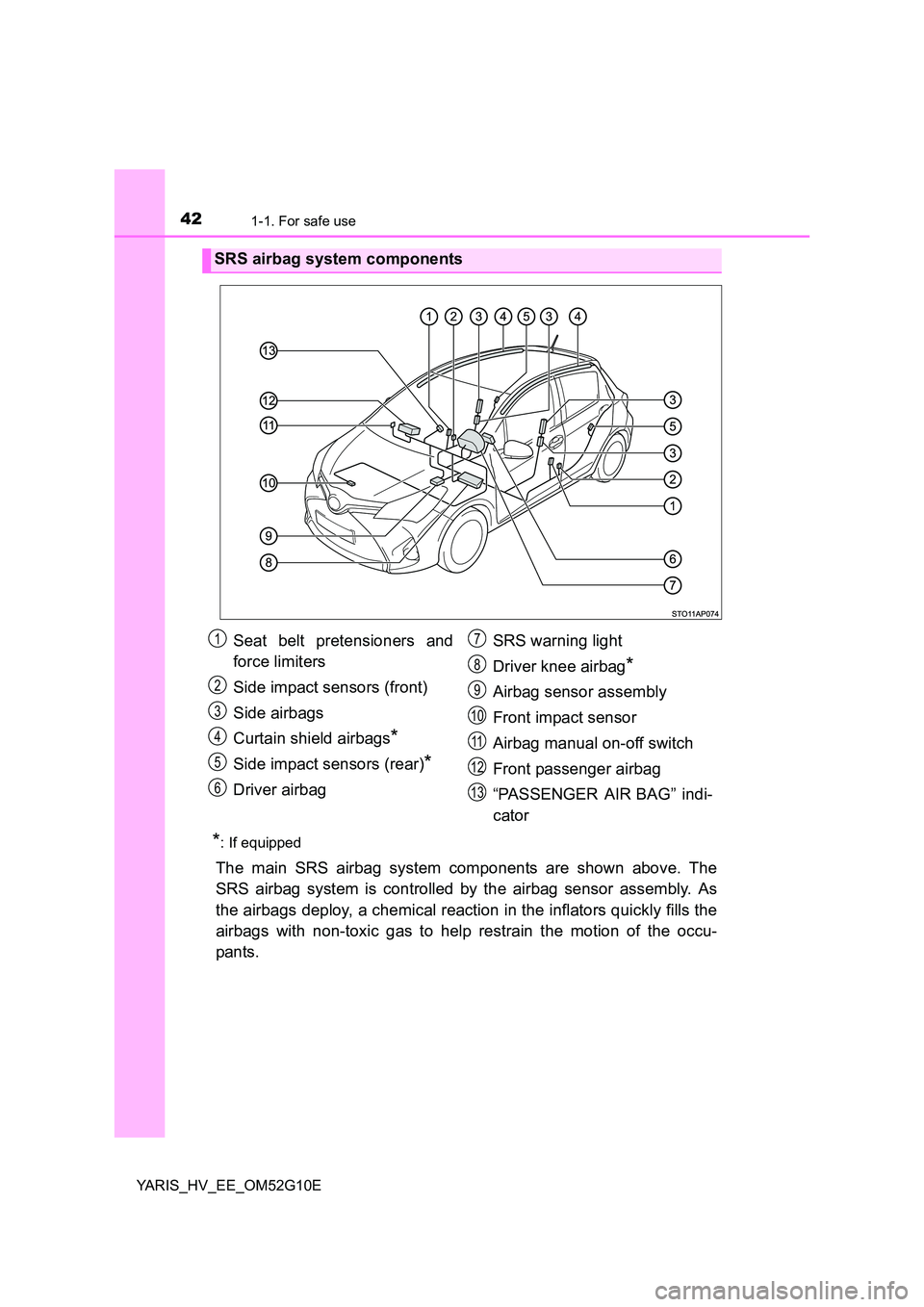
421-1. For safe use
YARIS_HV_EE_OM52G10E
*: If equipped
The main SRS airbag system components are shown above. The
SRS airbag system is controlled by the airbag sensor assembly. As
the airbags deploy, a chemical reaction in the inflators quickly fills the
airbags with non-toxic gas to help restrain the motion of the occu-
pants.
SRS airbag system components
Seat belt pretensioners and
force limiters
Side impact sensors (front)
Side airbags
Curtain shield airbags*
Side impact sensors (rear)*
Driver airbag
SRS warning light
Driver knee airbag*
Airbag sensor assembly
Front impact sensor
Airbag manual on-off switch
Front passenger airbag
“PASSENGER AIR BAG” indi-
cator
1
2
3
4
5
6
7
8
9
10
11
12
13
Page 43 of 492
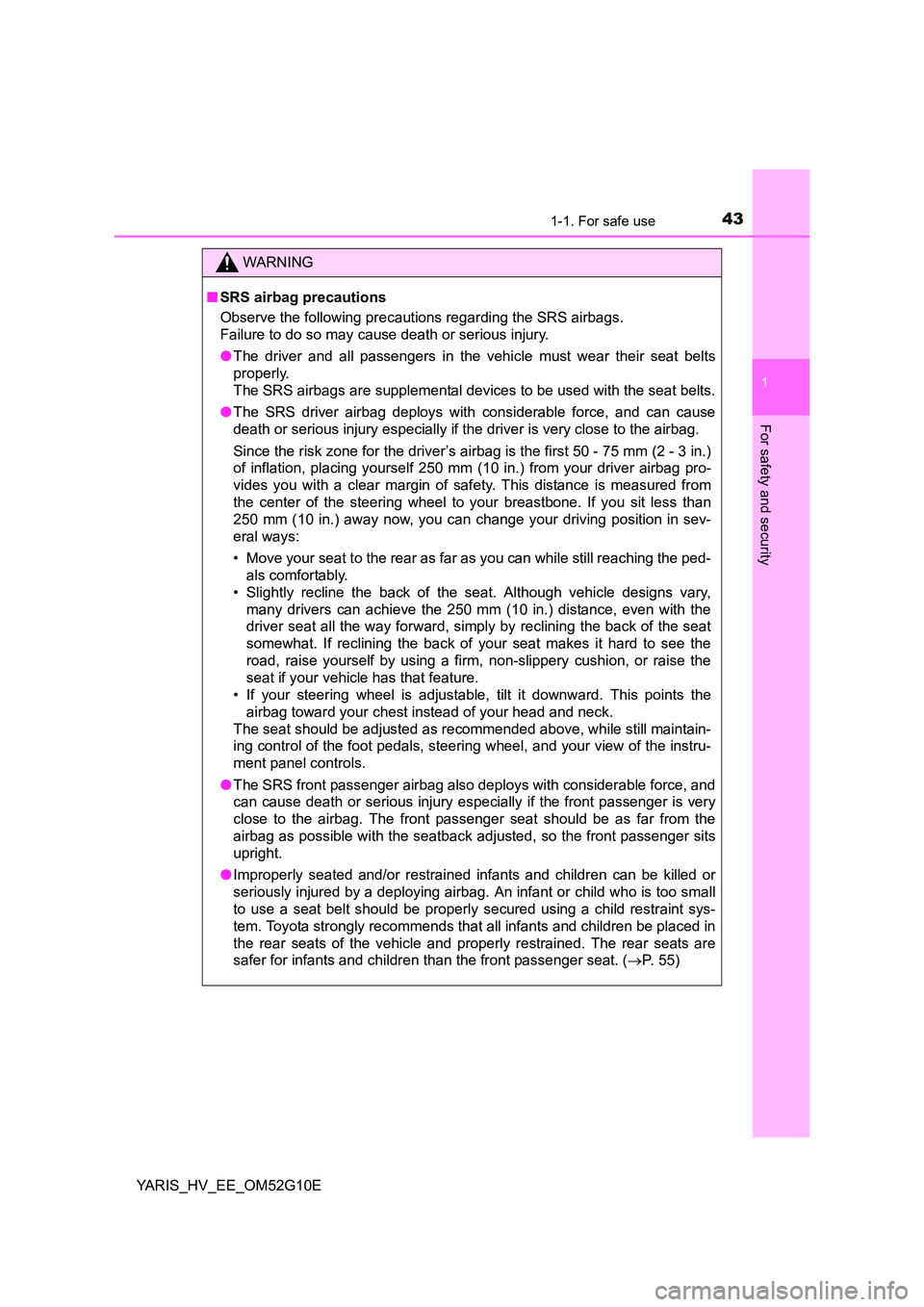
431-1. For safe use
1
For safety and security
YARIS_HV_EE_OM52G10E
WARNING
■SRS airbag precautions
Observe the following precautions regarding the SRS airbags.
Failure to do so may cause death or serious injury.
● The driver and all passengers in the vehicle must wear their seat belts
properly.
The SRS airbags are supplemental devices to be used with the seat belts.
● The SRS driver airbag deploys with considerable force, and can cause
death or serious injury especially if the driver is very close to the airbag.
Since the risk zone for the driver’s airbag is the first 50 - 75 mm (2 - 3 in.)
of inflation, placing yourself 250 mm ( 10 in.) from your driver airbag pro-
vides you with a clear margin of safety. This distance is measured from
the center of the steering wheel to your breastbone. If you sit less than
250 mm (10 in.) away now, you can change your driving position in sev-
eral ways:
• Move your seat to the rear as far as you can while still reaching the ped-
als comfortably.
• Slightly recline the back of the seat. Although vehicle designs vary,
many drivers can achieve the 250 mm (10 in.) distance, even with the
driver seat all the way forward, simply by reclining the back of the seat
somewhat. If reclining the back of your seat makes it hard to see the
road, raise yourself by using a firm, non-slippery cushion, or raise the
seat if your vehicle has that feature.
• If your steering wheel is adjustable, tilt it downward. This points the
airbag toward your chest instead of your head and neck.
The seat should be adjusted as recommended above, while still maintain-
ing control of the foot pedals, steering wheel, and your view of the instru-
ment panel controls.
● The SRS front passenger airbag also deploys with considerable force, and
can cause death or serious injury especially if the front passenger is very
close to the airbag. The front passenger seat should be as far from the
airbag as possible with the seatback adjusted, so the front passenger sits
upright.
● Improperly seated and/or restrained infants and children can be killed or
seriously injured by a deploying airbag. An infant or child who is too small
to use a seat belt should be properly secured using a child restraint sys-
tem. Toyota strongly recommends that all infants and children be placed in
the rear seats of the vehicle and proper ly restrained. The rear seats are
safer for infants and children than the front passenger seat. ( P. 55)
Page 53 of 492
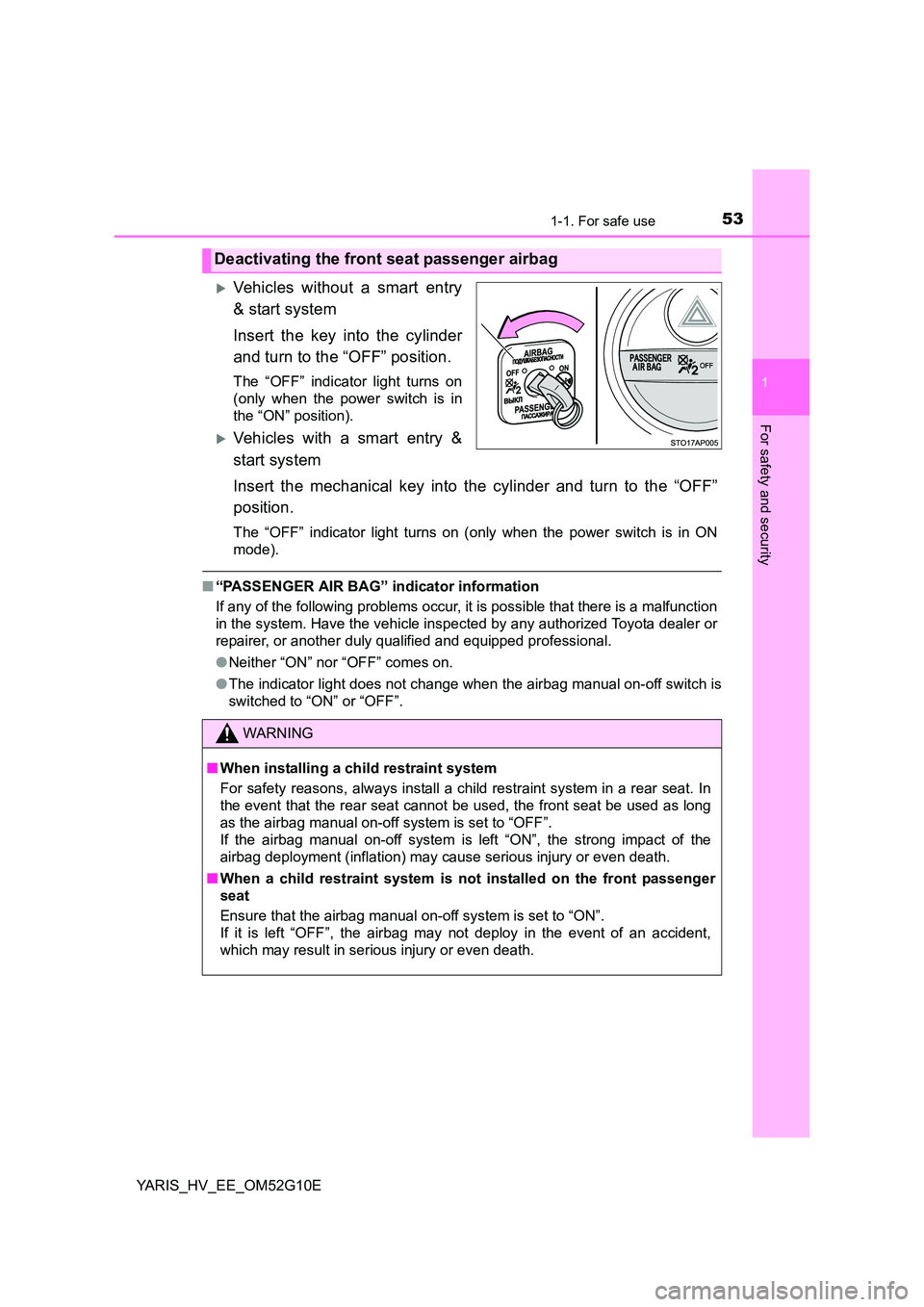
531-1. For safe use
1
For safety and security
YARIS_HV_EE_OM52G10E
Vehicles without a smart entry
& start system
Insert the key into the cylinder
and turn to the “OFF” position.
The “OFF” indicator light turns on
(only when the power switch is in
the “ON” position).
Vehicles with a smart entry &
start system
Insert the mechanical key into the cylinder and turn to the “OFF”
position.
The “OFF” indicator light turns on (only when the power switch is in ON
mode).
■ “PASSENGER AIR BAG” indicator information
If any of the following problems occur, it is possible that there is a malfunction
in the system. Have the vehicle inspected by any authorized Toyota dealer or
repairer, or another duly qualified and equipped professional.
● Neither “ON” nor “OFF” comes on.
● The indicator light does not change when the airbag manual on-off switch is
switched to “ON” or “OFF”.
Deactivating the front seat passenger airbag
WARNING
■ When installing a child restraint system
For safety reasons, always install a child restraint system in a rear seat. In
the event that the rear seat cannot be used, the front seat be used as long
as the airbag manual on-off system is set to “OFF”.
If the airbag manual on-off system is le ft “ON”, the strong impact of the
airbag deployment (inflation) may cause serious injury or even death.
■ When a child restraint system is not installed on the front passenger
seat
Ensure that the airbag manual on-off system is set to “ON”.
If it is left “OFF”, the airbag may not deploy in the event of an accident,
which may result in serious injury or even death.
Page 74 of 492
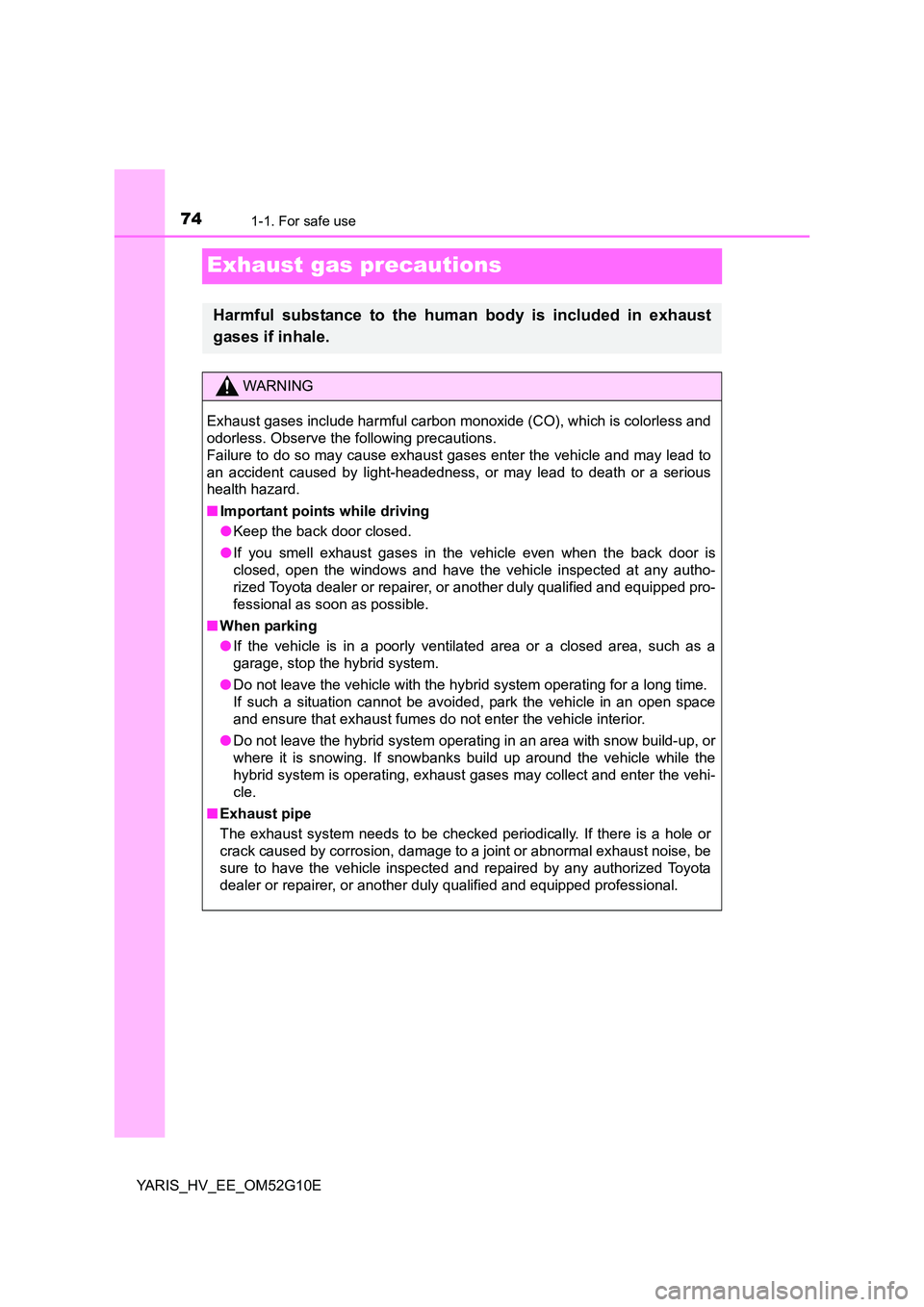
741-1. For safe use
YARIS_HV_EE_OM52G10E
Exhaust gas precautions
Harmful substance to the human body is included in exhaust
gases if inhale.
WARNING
Exhaust gases include harmful carbon monoxide (CO), which is colorless and
odorless. Observe the following precautions.
Failure to do so may cause exhaust gases enter the vehicle and may lead to
an accident caused by light-headedness, or may lead to death or a serious
health hazard.
■ Important points while driving
● Keep the back door closed.
● If you smell exhaust gases in the vehicle even when the back door is
closed, open the windows and have the vehicle inspected at any autho-
rized Toyota dealer or repairer, or another duly qualified and equipped pro-
fessional as soon as possible.
■ When parking
● If the vehicle is in a poorly ventilated area or a closed area, such as a
garage, stop the hybrid system.
● Do not leave the vehicle with the hybrid system operating for a long time.
If such a situation cannot be avoided, park the vehicle in an open space
and ensure that exhaust fumes do not enter the vehicle interior.
● Do not leave the hybrid system operating in an area with snow build-up, or
where it is snowing. If snowbanks build up around the vehicle while the
hybrid system is operating, exhaust gases may collect and enter the vehi-
cle.
■ Exhaust pipe
The exhaust system needs to be checked periodically. If there is a hole or
crack caused by corrosion, damage to a joint or abnormal exhaust noise, be
sure to have the vehicle inspected and repaired by any authorized Toyota
dealer or repairer, or another duly qualified and equipped professional.
Page 80 of 492
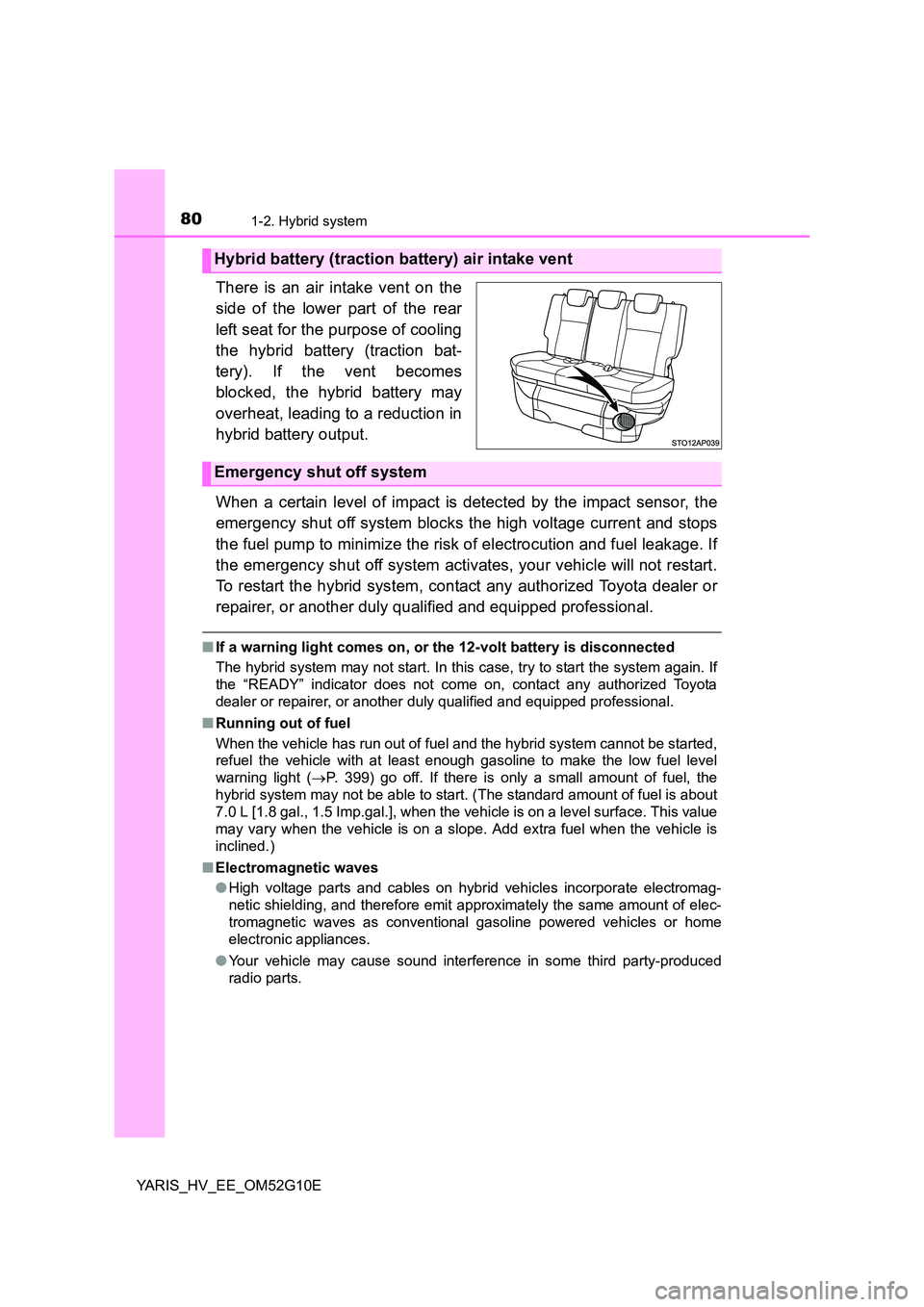
801-2. Hybrid system
YARIS_HV_EE_OM52G10E
There is an air intake vent on the
side of the lower part of the rear
left seat for the purpose of cooling
the hybrid battery (traction bat-
tery). If the vent becomes
blocked, the hybrid battery may
overheat, leading to a reduction in
hybrid battery output.
When a certain level of impact is detected by the impact sensor, the
emergency shut off system blocks the high voltage current and stops
the fuel pump to minimize the risk of electrocution and fuel leakage. If
the emergency shut off system activates, your vehicle will not restart.
To restart the hybrid system, contact any authorized Toyota dealer or
repairer, or another duly qualified and equipped professional.
■ If a warning light comes on, or the 12-volt battery is disconnected
The hybrid system may not start. In this case, try to start the system again. If
the “READY” indicator does not come on, contact any authorized Toyota
dealer or repairer, or another duly qualified and equipped professional.
■ Running out of fuel
When the vehicle has run out of fuel and the hybrid system cannot be started,
refuel the vehicle with at least enough gasoline to make the low fuel level
warning light ( P. 399) go off. If there is only a small amount of fuel, the
hybrid system may not be able to start. (The standard amount of fuel is about
7.0 L [1.8 gal., 1.5 Imp.gal.], when the vehicle is on a level surface. This value
may vary when the vehicle is on a slope. Add extra fuel when the vehicle is
inclined.)
■ Electromagnetic waves
● High voltage parts and cables on hybrid vehicles incorporate electromag-
netic shielding, and therefore emit approximately the same amount of elec-
tromagnetic waves as conventional gasoline powered vehicles or home
electronic appliances.
● Your vehicle may cause sound interference in some third party-produced
radio parts.
Hybrid battery (traction battery) air intake vent
Emergency shut off system
Page 91 of 492

91
2Instrument cluster
YARIS_HV_EE_OM52G10E
2. Instrument cluster
Warning lights and
indicators ........................... 92
Gauges and meters ............. 97
Multi-information display .... 100
Energy monitor/
consumption screen ........ 104
Page 92 of 492
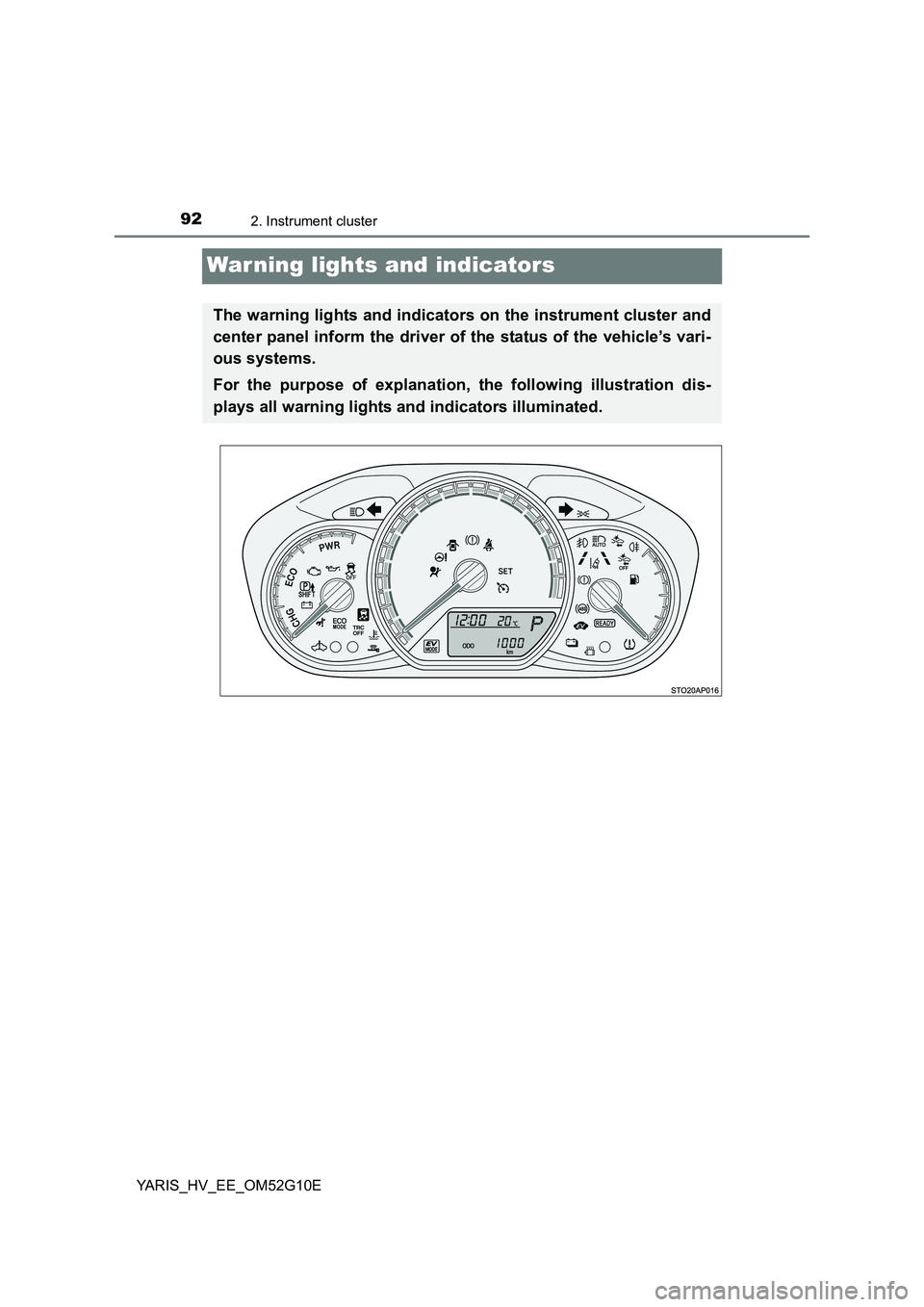
922. Instrument cluster
YARIS_HV_EE_OM52G10E
War ning lights and indicators
The warning lights and indicators on the instrument cluster and
center panel inform the driver of the status of the vehicle’s vari-
ous systems.
For the purpose of explanation, the following illustration dis-
plays all warning lights and indicators illuminated.
Page 93 of 492
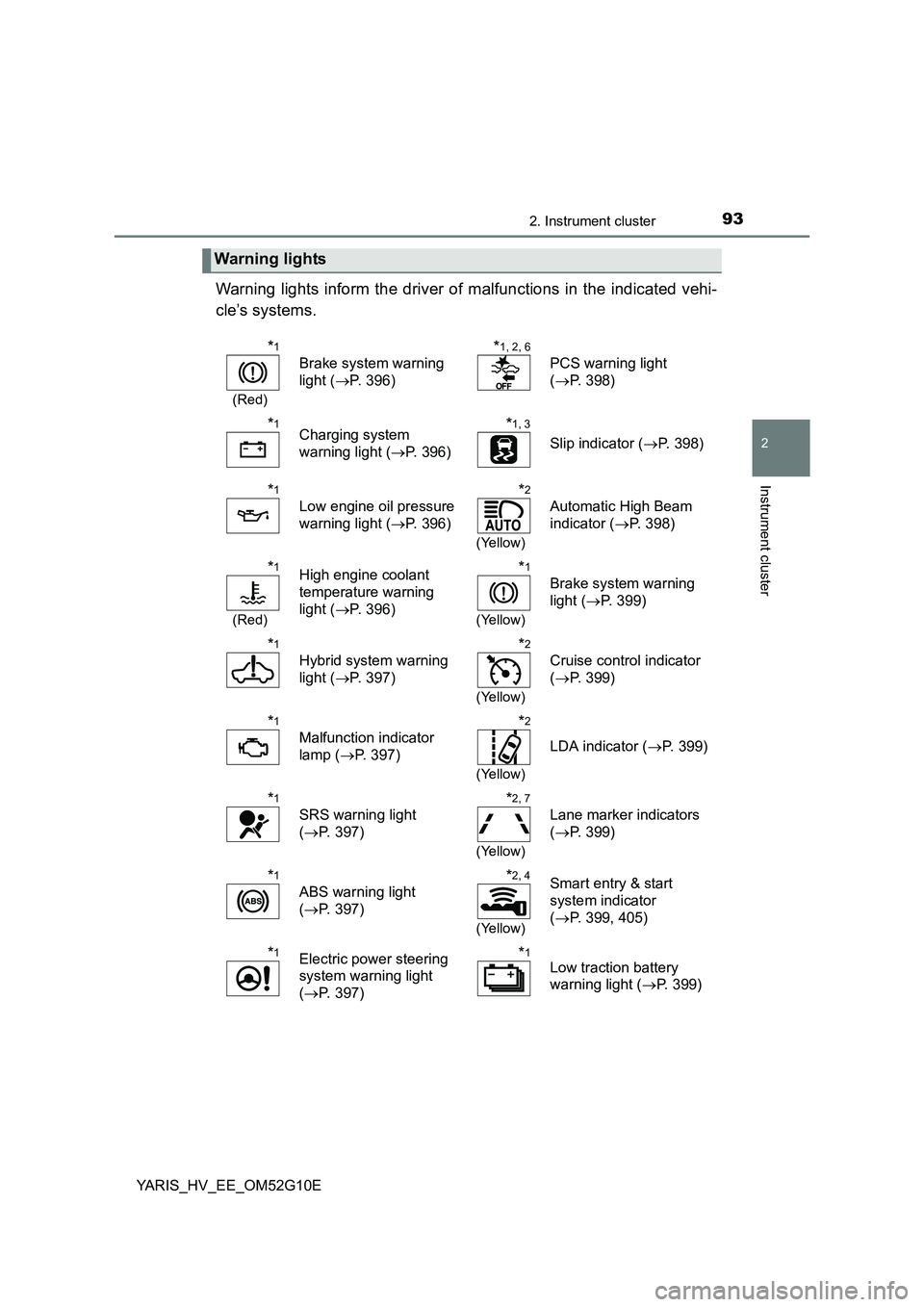
932. Instrument cluster
2
Instrument cluster
YARIS_HV_EE_OM52G10E
Warning lights inform the driver of malfunctions in the indicated vehi-
cle’s systems.
Warning lights
*1
(Red)
Brake system warning
light ( P. 396)
*1, 2, 6
PCS warning light
( P. 398)
*1Charging system
warning light ( P. 396)
*1, 3
Slip indicator (P. 398)
*1
Low engine oil pressure
warning light ( P. 396)
*2
(Yellow)
Automatic High Beam
indicator ( P. 398)
*1
(Red)
High engine coolant
temperature warning
light ( P. 396)
*1
(Yellow)
Brake system warning
light ( P. 399)
*1
Hybrid system warning
light ( P. 397)
*2
(Yellow)
Cruise control indicator
( P. 399)
*1
Malfunction indicator
lamp ( P. 397)
*2
(Yellow)
LDA indicator (P. 399)
*1
SRS warning light
( P. 397)
*2, 7
(Yellow)
Lane marker indicators
( P. 399)
*1
ABS warning light
( P. 397)
*2, 4
(Yellow)
Smart entry & start
system indicator
( P. 399, 405)
*1Electric power steering
system warning light
( P. 397)
*1
Low traction battery
warning light ( P. 399)
Page 94 of 492
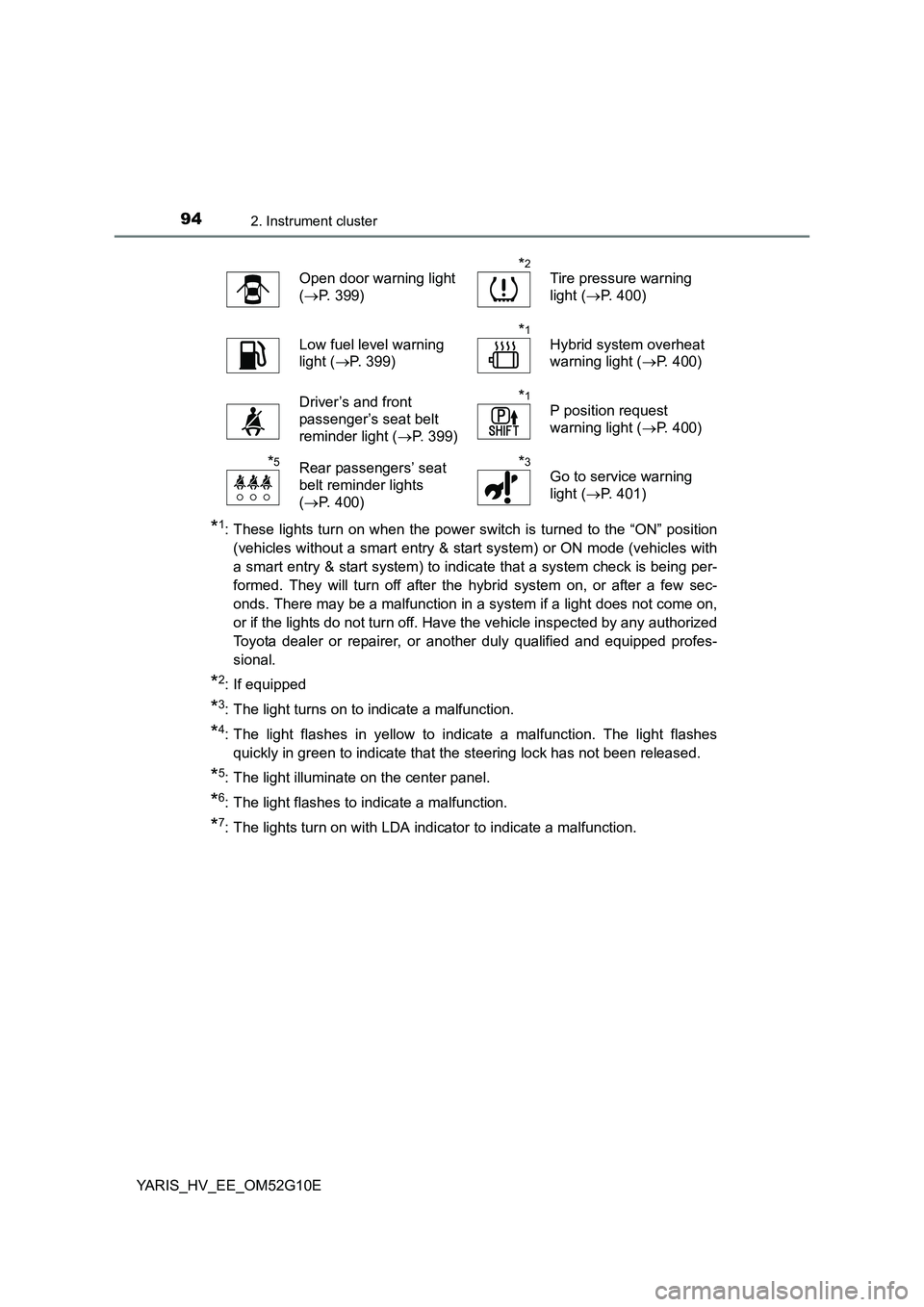
942. Instrument cluster
YARIS_HV_EE_OM52G10E
*1: These lights turn on when the power switch is turned to the “ON” position
(vehicles without a smart entry & star t system) or ON mode (vehicles with
a smart entry & start system) to indicate that a system check is being per-
formed. They will turn off after the hybrid system on, or after a few sec-
onds. There may be a malfunction in a system if a light does not come on,
or if the lights do not turn off. Have the vehicle inspected by any authorized
Toyota dealer or repairer, or another duly qualified and equipped profes-
sional.
*2: If equipped
*3: The light turns on to indicate a malfunction.
*4: The light flashes in yellow to indicate a malfunction. The light flashes
quickly in green to indicate that the steering lock has not been released.
*5: The light illuminate on the center panel.
*6: The light flashes to indicate a malfunction.
*7: The lights turn on with LDA indicator to indicate a malfunction.
Open door warning light
( P. 399)
*2
Tire pressure warning
light ( P. 400)
Low fuel level warning
light ( P. 399)
*1
Hybrid system overheat
warning light ( P. 400)
Driver’s and front
passenger’s seat belt
reminder light ( P. 399)
*1
P position request
warning light ( P. 400)
*5Rear passengers’ seat
belt reminder lights
( P. 400)
*3
Go to service warning
light ( P. 401)
Page 95 of 492
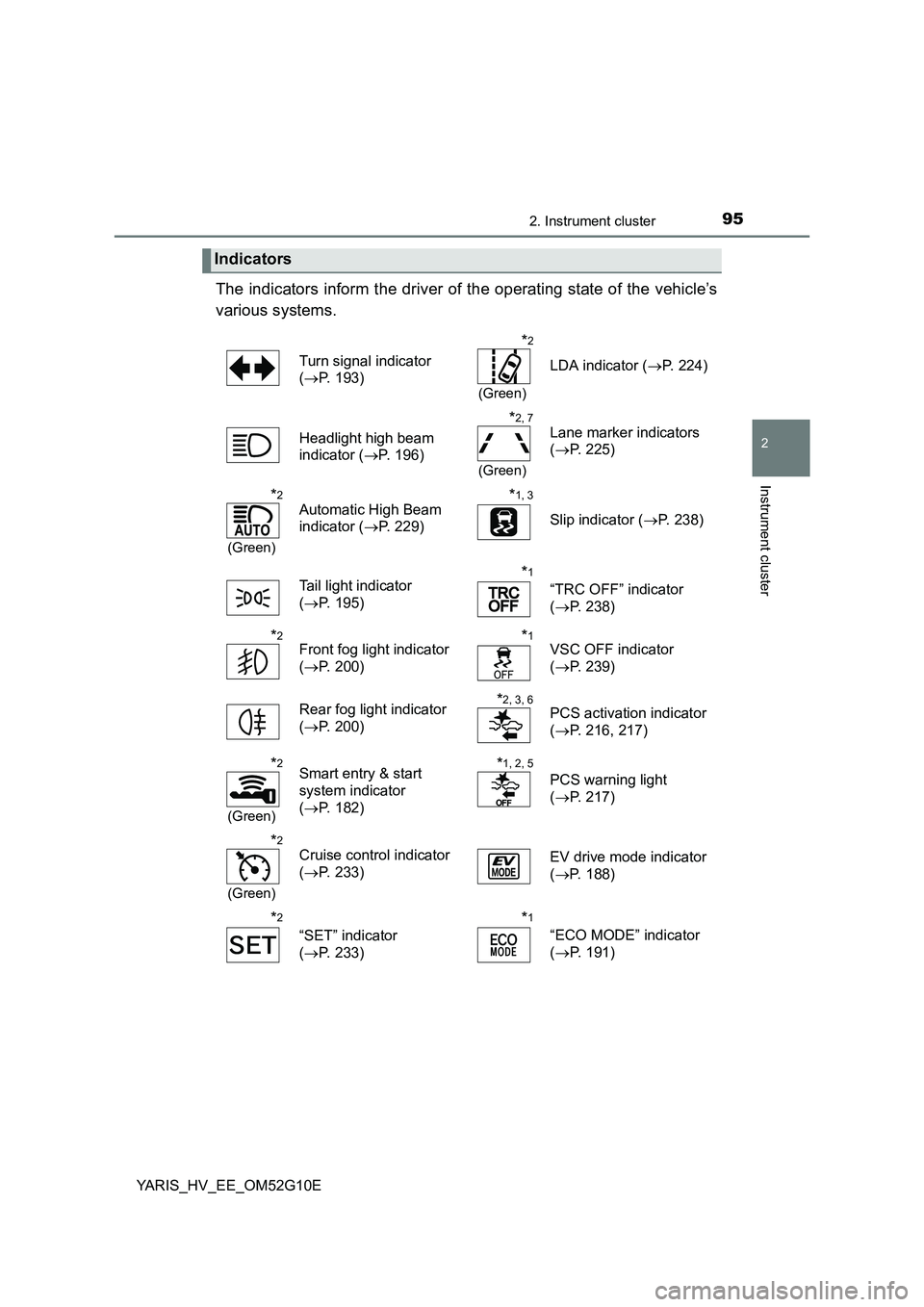
952. Instrument cluster
2
Instrument cluster
YARIS_HV_EE_OM52G10E
The indicators inform the driver of the operating state of the vehicle’s
various systems.
Indicators
Turn signal indicator
( P. 193)
*2
(Green)
LDA indicator (P. 224)
Headlight high beam
indicator ( P. 196)
*2, 7
(Green)
Lane marker indicators
( P. 225)
*2
(Green)
Automatic High Beam
indicator ( P. 229)
*1, 3
Slip indicator (P. 238)
Tail light indicator
( P. 195)
*1
“TRC OFF” indicator
( P. 238)
*2Front fog light indicator
( P. 200)
*1VSC OFF indicator
( P. 239)
Rear fog light indicator
( P. 200)
*2, 3, 6PCS activation indicator
( P. 216, 217)
*2
(Green)
Smart entry & start
system indicator
( P. 182)
*1, 2, 5
PCS warning light
( P. 217)
*2
(Green)
Cruise control indicator
( P. 233) EV drive mode indicator
( P. 188)
*2
“SET” indicator
( P. 233)
*1
“ECO MODE” indicator
( P. 191)